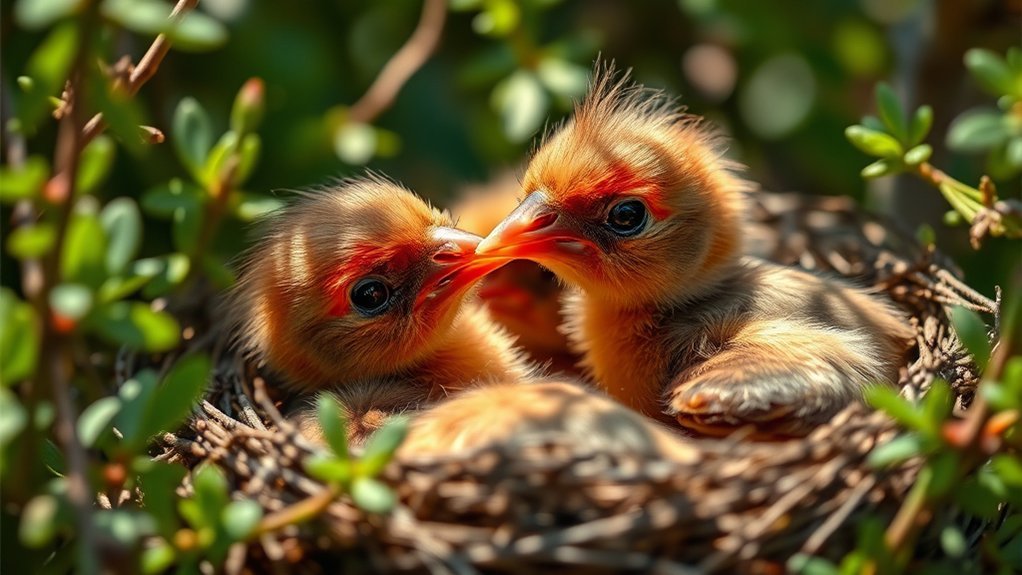Baby Cardinals: Facts and Characteristics
When you look at baby cardinals, you see something special. These little birds are about three to four inches long when they hatch. Right away, you can tell they need a lot of help from their parents. They are very fragile during their first week.
As they grow, you begin to notice changes. Their feathers start to change, and their beaks get bigger. These changes help them adapt to their environment. Learning about baby cardinals makes you think about how they survive and what role they play in nature.
Watching these tiny birds grow can be both interesting and fun!
A Quick Overview
Baby cardinals are tiny when they hatch. They are about three to four inches long. At first, they have no feathers, and their eyes are closed. They need their parents a lot during the first week. The parents help them by giving food and keeping them warm.
When they first hatch, baby cardinals have soft grayish-brown feathers with a bit of pale yellow. They don't have the bright red feathers that adult cardinals do. As they grow, their diet changes. They start eating insects, seeds, fruits, and nectar. This food helps them grow strong.
Baby cardinals also use some clever tricks to stay safe. They blend in with their surroundings to hide from predators. They can also hop quickly to escape danger. This helps them survive in nature.
Early Development Stages of Baby Cardinals

As soon as baby cardinals hatch, they're very small and need a lot of care.
When they first come out of their eggs, they've hardly any feathers and their eyes are closed. This means they rely completely on their parents for food and warmth.
During their first week, the baby cardinals are entirely dependent on mom and dad.
In the days that follow, you'll see them grow quickly. They start to get soft down feathers and their eyes will open, showing they're starting to grow up.
By around two weeks old, they begin to develop real feathers, and they start to flap their wings.
This is an important time for them as they prepare to leave the nest.
Watching these changes helps you appreciate how amazing these little birds really are!
Nesting Habits of Northern Cardinals
Northern cardinals like to build their nests in thick bushes and trees. They usually place their nests between 3 and 10 feet off the ground. During the time they raise their young, these birds work hard on their nests. They want to keep their baby birds safe and warm. Their chosen spots help protect them from predators and bad weather.
To make their nests, northern cardinals collect different materials, such as:
- Twigs and branches to form the nest.
- Grasses and leaves to line the inside.
- Mud to hold everything together.
- Feathers to keep their babies cozy.
Watching a cardinal build a nest is a fun sight. They show a lot of care and attention to detail, creating a safe home for their young.
Physical Characteristics of Baby Cardinals

Baby cardinals are cute little birds that look different from adult cardinals. When they're just a few days old, they're small, about three to four inches long. Instead of the bright red color of adult cardinals, baby cardinals have softer colors. They usually show shades of grayish-brown and pale yellow. Their feathers are soft and haven't grown into the bright plumage that adult cardinals have.
Baby cardinals have small beaks, but these beaks are a bit larger in proportion to their bodies. This helps them get the food they need to grow strong.
As you watch them, you can see how their different features will help them change into the vibrant red cardinals they'll become. It's exciting to think about their future!
Feeding and Nutrition for Fledglings
When baby cardinals leave the nest, they need different foods to grow strong. In the wild, their meals change a lot.
Here are four important foods they eat:
- Insects: Bugs like caterpillars and beetles are full of protein, which helps them grow.
- Seeds: Seeds, especially sunflower seeds, give them healthy fats and carbs for energy.
- Fruits: Berries and soft fruits keep them hydrated and provide vitamins.
- Nectar: Drinking nectar gives them a quick energy boost, especially when they're flying around.
Knowing what fledgling cardinals eat shows how they learn to be independent.
Getting the right mix of these foods is key for their health and strength as they start their new life outside the nest.
Parental Care and Protection

While baby birds start to explore their homes, their parents play a key role in their growth and safety. Cardinal parents show great care in building nests. They spend a lot of time making cozy homes that are often hidden in thick bushes to keep their young safe from enemies.
Even after the babies leave the nest, parents stay close. They watch over the fledglings and teach them important skills for survival. For example, they show them where to find food and help them recognize dangers.
As the young birds become more independent, the ongoing support from their parents helps them do well in nature. This strong bond between the parent and the chick is essential for their life and survival.
Vocalizations and Communication
Cardinal chicks start off quiet, but they quickly learn how to use sounds to talk to each other. These sounds help them connect with their parents and siblings.
Here are some important vocalizations they make:
- Chirps: These are high-pitched sounds. When chicks chirp, they're usually feeling hungry or scared. This lets their parents know they need help.
- Trills: These are cute, musical sounds. Chicks trill to coordinate with their brothers and sisters, which helps them feel close as a family.
- Calls: These are strong, clear sounds. When chicks make calls, they're warning others about danger. This helps everyone stay safe.
- Song: Adult cardinals sing beautiful songs. When chicks listen, they learn how to socialize and understand their own territory.
Through these sounds, cardinal chicks not only share what they need but also start to understand how to be part of their community. This helps them form friendships and stay safe in their environment.
Social Structure Within Cardinal Flocks
Cardinal flocks have a strong social structure that helps them survive and get along with each other. In these groups, cardinals build strong bonds. These friendships are important because they affect how the birds share food, protect their space, and talk to one another.
In a flock, some cardinals are more dominant. They often lead feeding and breeding activities. This social order creates a stable environment where younger cardinals can learn from the older ones.
Watching how they interact shows us the balance that keeps these flocks working well together. Understanding the way cardinals organize themselves helps us appreciate how they stay strong and adapt to different places.
It's fascinating to see how they all work as a community.
Growth Timeline: From Hatchling to Fledgling
Baby cardinals go through exciting changes as they grow from hatchlings to fledglings. This process takes several weeks and is important for their development.
Here's a simple timeline to understand their growth:
- Days 1-3: When they first hatch, baby cardinals need a lot of care. They can't see or move much and rely completely on their parents for food and warmth.
- Days 4-7: After a few days, their eyes open. They start to grow tiny feathers. This is an early sign that they're developing.
- Days 8-14: As they get older, they move around more. They flap their wings and demand more food from their parents.
- Days 15-21: Soon, they begin to test their flying skills. They'll leave the nest for short times and start to depend less on their parents.
Each step in this timeline helps them grow strong and ready for life outside the nest.
Watching them grow is a wonderful experience!
Plumage Changes as They Mature
After baby cardinals leave their nest, their feathers change a lot. At first, they're a dull brown color. This helps keep them safe as they grow.
But as time goes on, their feathers turn into bright reds and blacks that adult cardinals have. This colorful change is important. It helps them fit in and find mates.
Baby cardinals slowly shed their old feathers. They replace them with new, stronger feathers. As they explore the world, you can see them flutter with excitement and gain confidence.
Watching these changes helps you understand their journey to becoming adults. It also makes you appreciate how beautiful these birds really are.
Predators and Survival Strategies
Baby cardinals might look fragile because of their dull colors, but they've some smart ways to stay safe from predators.
Here are a few tricks they use:
- Blending In: Their plain feathers help them hide among leaves and branches.
- Staying Quiet: When they feel danger, they stay still and silent.
- Safe Homes: Their parents build nests in thick bushes, which keeps them hidden.
- Hiding Skills: As the babies grow, they learn to hop and hide quickly to escape threats.
These smart strategies help baby cardinals survive and grow up safely.
Habitat Preferences of Juvenile Cardinals
Juvenile cardinals like to live in different places where they can stay safe and find food. You can spot them in city parks and near the edges of forests. These spots have plenty of shrubs, which they really like. These areas help keep them hidden from predators and give them enough food to grow strong.
During breeding season, juvenile cardinals set up small territories where food is easy to find. They need a steady supply of food to help them grow. However, changes in the weather can affect where they live and how easy it's to find food. They must adapt to these changes to survive.
Knowing what juvenile cardinals need can help you create spaces that support their growth. By planting shrubs and providing food sources, you can help these beautiful birds thrive.
Watching them grow in your community can be a wonderful experience.
The Role of Baby Cardinals in Ecosystems
Baby cardinals play an important role in their ecosystems. They help the environment in many ways, especially by spreading seeds.
- Baby cardinals eat many seeds, which helps plants grow.
- Their droppings carry seeds to new places.
- They help seeds start to grow into new plants.
- Other animals come to eat baby cardinals, which helps keep nature balanced.
By doing these things, baby cardinals support a healthy and lively ecosystem.
They not only help plants thrive but also create a home for many other creatures. It's amazing how such small birds can make a big difference!
Frequently Asked Questions
What Color Are Baby Cardinals When They First Hatch?
When baby cardinals first hatch, they are soft and greyish-brown. They do not have the bright red colors that adult cardinals show. As they get bigger, they start to change. They grow feathers that are red and brown. These colors make them look like the adult cardinals we know and love. Watching them grow is really special!
How Long Do Baby Cardinals Stay in the Nest?
Baby cardinals stay in their nest for about 10 to 14 days. During this time, they grow stronger and get ready to fly for the first time. You'll see them develop as they prepare to leave the nest and explore the world around them. It's exciting to watch them grow!
Do Both Parents Care for Baby Cardinals?
Yes, both parent cardinals care for their baby chicks. They work together to feed them. This teamwork helps the chicks grow strong and stay healthy. By sharing their duties, both parents show how much they care for their young ones. Their love and support create a safe home for the babies to thrive.
At What Age Do Baby Cardinals Learn to Fly?
Baby cardinals learn to fly when they are about 20 days old. At this age, they start to become fledglings. Fledglings take short flights to practice their wings. They gain confidence as they fly a little more each day. Soon, they are ready to explore outside their nest. Watching them learn to fly is exciting! It's a big step for these little birds.
Can Baby Cardinals Survive Alone After Leaving the Nest?
Baby cardinals face challenges when they leave the nest. They don't have much experience and need help from their parents. If they leave the nest too soon, they can struggle to survive on their own. Without adult cardinals nearby, it can be tough for them to find food and stay safe. It is best for them to stay close to their parents after they leave the nest until they learn how to take care of themselves.

Luna is the passionate founder and author of Birds and You, a website dedicated to sharing her love for birds with fellow enthusiasts. Through her engaging articles and guides, she aims to educate and inspire others to explore the fascinating world of birds. When she’s not writing, you can find Luna observing birds in their natural habitats or sharing beautiful bird photography on Pinterest. Join her on this journey to celebrate and protect our feathered friends!







